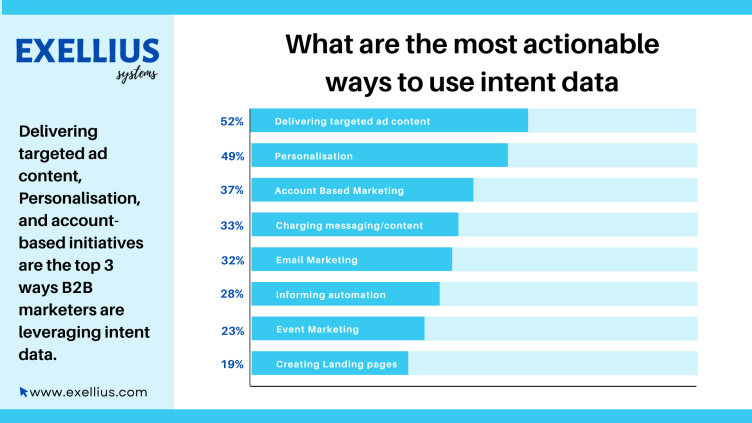
Data at the account level that signifies interest in a certain business category or set of goods and services is known as intent data. (B2B Marketers)
Intent data is based on how people consume material on the internet (often referred to as “3rd-party intent”) or it can be based on how customers interact directly with business properties like a website (also known as 1st party intent data or engagement data). With the help of contextually relevant and customised messaging, it is possible to find interested prospects B2B Marketers.
Additionally, you may use intent data to better understand your open possibilities and current clients so that you can guide them through the conversion, retention, and expansion funnels.
B2B marketers today have access to more information than ever, but how are they using intent data to differentiate their brand from the competition?
Insight #1: B2B Marketers Are Using Intent Data to Target New Accounts
B2B marketers are adopting the use of intent data with prospecting efforts in mind. Identifying new accounts to target, aligning their sales and marketing efforts, and prioritizing accounts for prospecting are at the top of the list of primary goals according to 56%, 51%, and 38% of B2B marketers, respectively.

Key Takeaway: If your martech goal is efficiency, consider an account-based approach. Account-based marketing (ABM) means taking a fit-first approach to B2B marketing, ensuring you’re only targeting the accounts with the highest likelihood to buy. Research shows that 94% of marketers find ABM successful at achieving their primary objectives. The more targeting you become in identifying your best audience, the more you can improve efficiency in your overall programs.
For 56% of B2B marketers, data quality is a major challenge when using intent signals, and half of those surveyed report having trouble making intent data actionable. Having a strategy in place to capitalize on intent data allows marketers to more successfully run targeted content and ad campaigns, better enable the sales team and drive more revenue.

Key Takeaway: Intent data can be seamlessly into ABM platforms, allowing for effortless implementation. This enables marketers to quickly take action on insights and drive account growth at scale.
When adding an intent solution to a technology stack, it is crucial for marketers to first evaluate goals to better define what they need. This prevents bloating a tech stack and paying for unnecessary tools. Over two-thirds (67%) of marketers are most concerned with the quality of data being delivered from an intent data solution, while 44% report that the source of data is of utmost importance.

Key Takeaway: Above all, B2B marketing technology needs to be user-friendly and customizable. You’ll want to look for tools that allow you to build and measure your programs the way that makes the most sense for your business. If you want to target specific accounts, the good news is that technology to support your strategy is not exclusively for enterprise companies with large budgets—now, small and mid-size companies have access to account-based tools that are fast, affordable, and customizable.
Intent data gives marketers the ability to leverage personalization across various channels. About half of B2B marketers report that delivering targeted ad content (52%) and personalization efforts (49%) are the most actionable ways to use intent data. From ad copy to landing pages to the subject line in sales outreach, intent data can fuel many areas of sales and marketing.

Key Takeaway: The more you know about what your accounts are looking for, the easier it is to reach them with the right offer. That’s where intent data can help inform digital advertising personalization for key
accounts based on topics they’re surging on.
Contact Us for More and visit our blog page
And do follow us on LinkedIn


